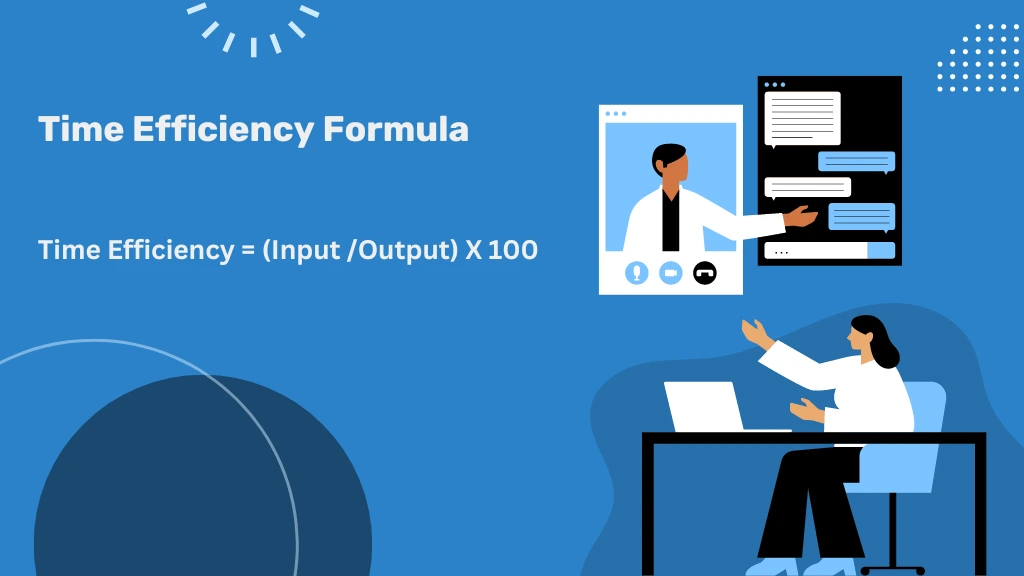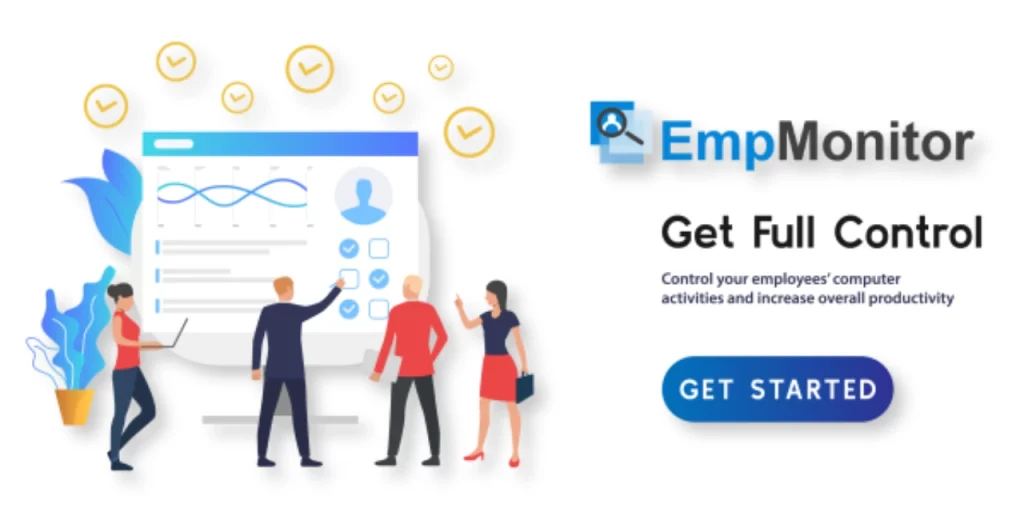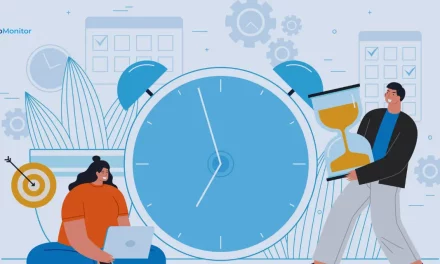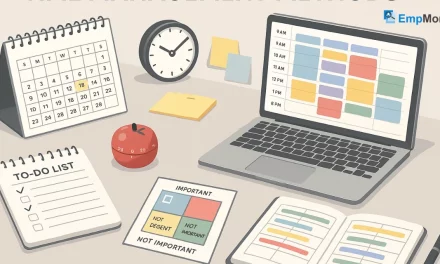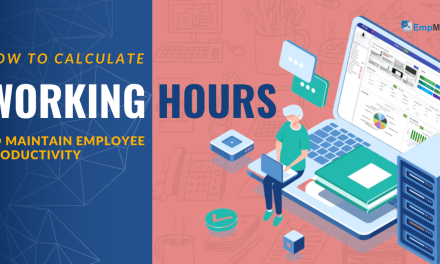Time is the most valuable resource in any business, yet it is often the most mismanaged. Imagine getting more done in less time without compromising on quality. That is what you can achieve by being time efficient.
In this blog, we will explore the meaning of time efficiency, dive into real-life case studies, and look at productivity techniques. You will learn practical formulas and the undeniable benefits of time-efficient employees.
Ready to transform how you manage time? Let us dive in.
Listen To The Podcast Now!
What Does “Time Efficient” Mean?
At its essence, being time efficient means maximizing the use of the time available to you. It is about maximizing productivity without unnecessary waste. But how can we quantify that? Let us break down the time efficient meaning in a way that applies directly to business.
Time Efficiency Formula
Here is an easy formula to consider:
Time Efficiency = (Input /Output) X 100
The Time Efficiency Formula helps you see how well you use your time.
Input is the total time you spend (like hours worked).
Output is what you produce or accomplish in that time (like products made or tasks completed).
The formula tells you how much you achieved compared to the total time spent, expressed as a percentage.
Example:
If you spend 10 hours on a project and get 100 tasks done, you use this formula to find out how efficiently you work. Higher efficiency means you are doing more with the time you have.
The formula helps you measure if you are using your time effectively or if there is room for improvement.
Congrats! You have mastered time efficiency. But have you tapped into time effectiveness? While efficiency is about speed, effectiveness means focusing on the right tasks that drive results. Are you curious to know how time effectiveness can elevate your productivity? Let us dive into it!
Time Efficiency vs. Time Effectiveness: Know The Difference
Time efficiency and effectiveness are important for managing your time, but they focus on different aspects. Here is a clear explanation of each, with examples to illustrate their differences:
Time Efficiency
Definition: Time efficiency refers to how quickly and resourcefully you complete tasks. It is about doing things with minimal wasted time and effort.
Focus: Speed and resourcefulness in completing tasks.
Example: Suppose you are preparing a report. You have been time efficient by using a well-organized template and the report in 2 hours instead of 4 hours by avoiding distractions and streamlining your process. You accomplished the same task in less time, using your available time.
Time Effectiveness
Definition: Time effectiveness is about focusing on the right tasks that align with your goals and priorities. It is not just about how fast you work but whether you are working on tasks that contribute to achieving your objectives.
Focus: Prioritizing tasks that have the most significant impact on your goals.
Example: Imagine you have a list of 20 tasks in your To-do list, but only a few are crucial for a big project due soon. If you focus on the critical tasks that will move the project forward and complete them efficiently, even if it means postponing less essential tasks, you are being time-effective. You are spending your time on activities that will lead to meaningful progress.x
How They Interrelate
Case: Preparing a Project Report
Time Efficiency:
Use a well-organized template and minimize distractions to complete the report in 2 hours instead of 4. This demonstrates time efficiency by focusing on how quickly the task can be done.
Time Effectiveness:
Identify the most important sections of the report that will significantly impact the project’s success, such as key findings and recommendations. Prioritize writing those first, even if it means postponing less critical details. This shows time effectiveness by ensuring you are working on the right tasks.
Combined Use:
By focusing on both time efficiency and time effectiveness, you can:
Finish the report quickly (time efficiency) while ensuring it addresses the most crucial aspects (time effectiveness). This approach ensures that you are not only working fast but also making meaningful progress toward your project goals.
In summary, using both concepts together helps you complete the report promptly and ensure it has a significant impact, leading to better overall results.
Next, we will explore time efficient productivity techniques, becoming more time efficient, and improve productivity .
Time Efficient Productivity Techniques
One of the best ways to improve time efficiency and productivity is through structured productivity techniques. Here are a few proven time efficient methods:
Pomodoro Technique
This technique involves dividing your work into a 25-minute segment called “Pomodoros,” with a 5-minute break. Once you have finished four Pomodoros, take a longer break of 15-30 minutes.
The Pomodoro Technique helps maintain high productivity by encouraging intense focus during each session and preventing burnout with regular breaks. It is great for managing time on tasks that require deep concentration and avoiding the mental fatigue that can come from long, uninterrupted work periods.
Example: To apply the Pomodoro Technique, start by choosing a specific task you want to work on, like writing a paper or studying for an exam. Set a timer for 25 minutes and focus on that task without any distractions until the timer goes off. Once the 25 minutes are up, take a 5-minute break to stretch, grab a drink, or relax. After four of these focused sessions (called Pomodoros), take a longer break of 15-30 minutes to recharge. This method helps you maintain concentration while preventing burnout, making your work more productive and manageable.
Time Blocking
This time efficient approach involves designating specific time blocks for various tasks or activities throughout your day. By assigning a set period to each task, you can minimize distractions and ensure you dedicate adequate time to what needs to be done. Time blocking helps to create a structured day, making it easier to stay on track and manage your workload and assisting you to be time efficient.
Example: You might block out 9:00-10:00 AM for email management, 10:00-12:00 PM for project work, and 1:00-2:00 PM for meetings. By having a clear schedule, you focus solely on the task at hand during each time block.
Eisenhower Matrix
This time efficient tool helps you prioritize tasks based on urgency and importance. The matrix categorizes tasks into four categories:
- Urgent and Important (Do these immediately)
- Important but Not Urgent (Schedule these)
- Urgent but Not Important (Delegate these if possible)
- Reduce or avoid tasks that are neither urgent nor important.
By organizing tasks into categories, you can prioritize what truly matters and avoid getting caught up in less important activities.
Example: If you have a deadline for an urgent project presentation, it goes to the top of your list. A routine update that is not pressing might be necessary but not urgent, so you schedule it for later. Tasks like unnecessary meetings that do not contribute much can be delegated or removed from your to-do list.
Cutting down on meetings
When companies remove unnecessary meetings, they enable workers to have more uninterrupted time to focus on important tasks and be time efficient. It promotes a more efficient work environment where employees can engage in “deep work” — concentrating without distractions on complex projects, often leading to higher productivity and better results.
Ready to see how time efficient employees can benefit your company? Keep reading to learn about the tangible rewards of better time management.
Benefits Of Time Efficient Employees
Time efficient employees bring immense value to both themselves and the organization. Here is how mastering time management creates a ripple effect of benefits:
Better work-life balance: Time efficient employees stick to their schedules, allowing them to juggle work and personal commitments better. This balance creates happier, more motivated individuals.
Higher quality output: With focused attention and minimal distractions, employees can produce higher-quality work, resulting in more consistent and polished outcomes.
Increased productivity: Managing time well means employees can accomplish more without needing extra hours, driving higher productivity without the stress of constant catch-up.
Fewer missed deadlines: Proper time allocation allows employees to prioritize tasks, meet deadlines effortlessly, and stay ahead of schedule.
Career growth opportunities: Time-efficient employees free up space to focus on professional goals, opening paths for career advancement and new challenges.
Lower operational costs: By getting tasks done more efficiently, employees reduce resource wastage, contributing to cost savings for the organization.
Reduced stress levels: Good time management eliminates the pressure of last-minute work, leading to a calmer, more focused environment that benefits employees and employers.
Higher operational efficiency: When employees consistently perform at their best with fewer errors, the company enjoys smoother operations and enhanced profitability.
A team of time efficient employees is a powerful asset, one that leads to lasting success for both individuals and the organization as a whole!
Also Read
WHY SHOULD EFFECTIVE TIME MANAGEMENT BE USED ROUTINELY?
HOW TO IMPROVE PRODUCTIVITY AND EFFICIENCY WITH TIME MANAGEMENT SOFTWARE?
How to Track Time Efficiency with Tools
Efficient time management is one thing, but keeping track of it is equally important. Enter time tracking software.
With the right time tracker, companies can monitor how much time employees spend on tasks. EmpMonitor provides detailed reports that enable management to spot productivity bottlenecks early and resolve them before they escalate into major problems.
Now that we have seen the tool. Let us dive deeper into what EmpMonitor does.
EmpMonitor – Workforce Management Software
EmpMonitor is a powerful time tracking software designed to prevent time theft and keep you informed about your employees’ productivity. With EmpMonitor, you can easily manage your team and monitor their progress in real-time. It offers a range of advanced features to enhance your team’s efficiency. Let us explore some of its standout features.
Time Tracking
Keep track of every minute of your employee’s working hours to eliminate time-wasting gaps and boost productivity.
Clear Insight with Screenshots
Automatically capture screenshots at set intervals. So you can easily view workflow details on a single dashboard for better evaluation.
Real-time Updates with Chat Monitoring
Monitor the time your team spends on chat and social apps during work hours to help them stay focused.
Insightful Reports
Get clear, data-rich reports that make it easy to see employee engagement and analyze team performance through automated timesheets.
App & Website Usage
Know which websites and apps your employees are using and see how much time they spend on work-related versus non-work-related tasks.
Stealth Mode
Monitor activities discreetly- EmpMonitor runs in the background without being visible in the programs list or Task Manager.
Incorporate EmpMonitor into your team to boost performance and ensure long-term success. Achieving long-term goals requires well-thought-out strategies with a clear vision, and now is the perfect time to discuss effective time management strategies that can drive sustainable results.
Long-Term Strategies for Maintaining Time Efficiency
Implementing efficiency strategies is just the start. Businesses need to focus on maintaining time efficiency in long-term:
Monitor Time Tracking Data Closely: Regularly review time tracking data to identify patterns in how employees use their time. This helps pinpoint areas where inefficiencies exist, such as tasks that take longer than expected or periods of inactivity. By recognizing these patterns, managers can make informed decisions about resource allocation and process improvements to enhance productivity.
Employee Training: Providing training programs equips employees with essential time management skills and techniques. This may include prioritization methods, goal setting, and the use of productivity tools. Well-trained employees are better prepared to manage their time effectively, leading to increased efficiency and job satisfaction.
Regular Feedback: Maintaining open lines of communication allows managers to give employees feedback on their time management practices. This helps employees understand how their time usage impacts overall team and organizational performance. Constructive feedback can motivate employees to improve their time management skills and align their efforts with company goals.
By adopting these strategies, companies can ensure their workforce remains productive over the long term.
Conclusion
Time efficiency is more than just a buzzword- it is a game-changer for boosting productivity and optimizing business operations. Throughout this blog, we have uncovered how mastering time efficiency can lead to better work outcomes, from improving individual performance to enhancing overall organizational success.
With techniques like the Pomodoro Technique, time blocking, and the Eisenhower Matrix, you can streamline workflows, reduce stress, and drive higher-quality results. With tools like EmpMonitor, you can track and fine-tune your team’s time management, ensuring that efficiency becomes a cornerstone of your work culture.
FAQs
Why is time efficiency beneficial?
Managing time efficiently enables individuals to meet deadlines, handle responsibilities easily, reduce stress, improve focus, and maintain a healthier work-life balance.
What are the five essentials of time management?
Incorporate these five tips to minimize distractions and boost productivity at work:
- Set reminders for all your tasks.
- Plan your day with a daily schedule.
- Assign a time limit to each task.
- Eliminate distractions.
- Build a consistent routine.
What is Work Time Efficiency?
Work time efficiency refers to the amount of work an individual can complete in a single day. This concept is frequently used to compare the performance of two workers. A worker’s effectiveness can be assessed through their efficiency; if someone is less efficient, it will take them longer to finish their tasks.


